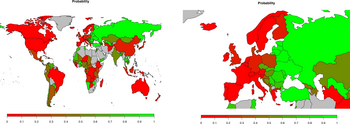
Back مساهمة محددة وطنيا Arabic Vnitrostátně stanovené příspěvky Czech Nationally Determined Contributions German Contribución Determinada a Nivel Nacional Spanish Contributions déterminées au niveau national French Enyemaka mba IG Contributi determinati a livello nazionale Italian 国が決定する貢献 Japanese Nationally Determined Contributions Dutch Contribuição Nacionalmente Determinada Portuguese

The nationally determined contributions (NDCs) are commitments that countries make to reduce their greenhouse gas emissions as part of climate change mitigation. These commitments include the necessary policies and measures for achieving the global targets set out in the Paris Agreement. The Paris Agreement has a long-term temperature goal which is to keep the rise in global surface temperature to well below 2 °C (3.6 °F) above pre-industrial levels. The treaty also states that preferably the limit of the increase should only be 1.5 °C (2.7 °F). To achieve this temperature goal, greenhouse gas emissions should be reduced as soon as, and by as much as, possible.[2] To stay below 1.5 °C of global warming, emissions need to be cut by roughly 50% by 2030. This figure takes into account each country's documented pledges or NDCs.[3]
NDCs embody efforts by each country to reduce national emissions and adapt to the impacts of climate change.[4] The Paris Agreement requires each of the 193 Parties to prepare, communicate and maintain NDCs outlining what they intend to achieve.[4] NDCs must be updated every five years.[4]
Prior to the Paris Agreement in 2015, the NDCs were referred to as intended nationally determined contributions (INDCs) and were non-binding. The INDCs were initial, voluntary pledges made by countries, whereas the NDCs are more committed but also not legally binding.
The rates of emissions reductions need to increase by 80% beyond NDCs to likely meet the 2 °C upper target range of the Paris Agreement (data as of 2021).[5] The probabilities of major emitters meeting their NDCs without such an increase is very low. Therefore, with current trends the probability of staying below 2 °C of warming is only 5% – and if NDCs were met and continued post-2030 by all signatory systems the probability would be 26%.[5][1]
- ^ a b Liu, Peiran R.; Raftery, Adrian E. (9 February 2021). "Country-based rate of emissions reductions should increase by 80% beyond nationally determined contributions to meet the 2 °C target". Communications Earth & Environment. 2 (1): 29. Bibcode:2021ComEE...2...29L. doi:10.1038/s43247-021-00097-8. ISSN 2662-4435. PMC 8064561. PMID 33899003.
 Available under CC BY 4.0.
Available under CC BY 4.0.
- ^ UNFCCC. "The Paris Agreement". unfccc.int. Archived from the original on 19 March 2021. Retrieved 18 September 2021.
- ^ Schleussner, Carl-Friedrich. "The Paris Agreement – the 1.5 °C Temperature Goal". Climate Analytics. Retrieved 2022-01-29.
- ^ a b c Cite error: The named reference
:2was invoked but never defined (see the help page). - ^ a b Cite error: The named reference
:1was invoked but never defined (see the help page).